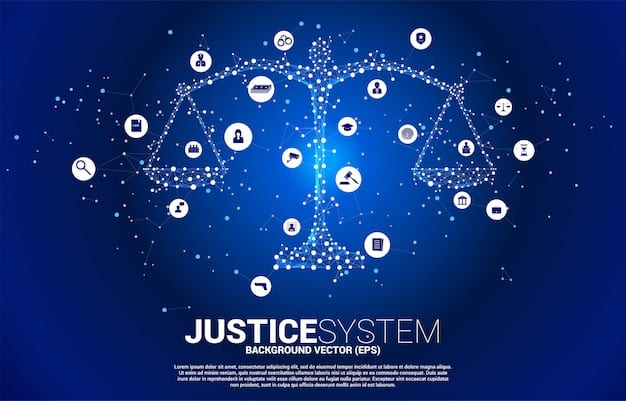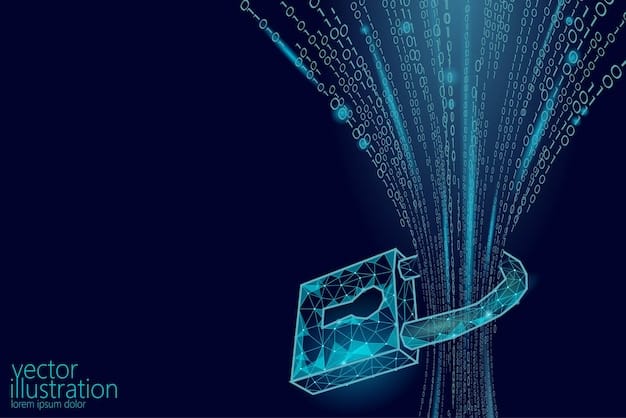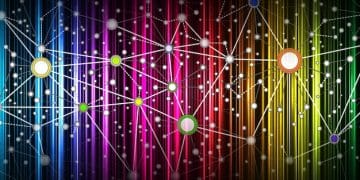AI and the US Legal System: Navigating Ethical and Legal Challenges

The US legal system faces increasing challenges as artificial intelligence (AI) becomes more prevalent, requiring examination of ethical considerations, legal frameworks, and potential impacts on existing laws.
The rise of artificial intelligence (AI) presents unprecedented challenges to legal systems worldwide, and the **US Legal System: Addressing the Ethical and Legal Challenges of Artificial Intelligence** is at the forefront of this transformation. Understanding how AI interacts with established laws and ethical principles is crucial for policymakers, legal professionals, and the public alike.
Understanding AI’s Impact on the Legal System
Artificial intelligence is no longer a futuristic concept; it’s a reality changing various industries, including the legal field. From automating legal research to assisting in predictive policing, AI applications are rapidly evolving. This technological advancement brings numerous benefits but also introduces complex ethical and legal dilemmas that the US legal system must address effectively.
AI in Legal Practice
AI is being used to streamline legal processes and improve efficiency. Tools powered by AI algorithms can analyze vast amounts of data, predict case outcomes, and even draft legal documents. This increased efficiency raises questions about the role of human lawyers and the potential for job displacement.
Ethical Considerations
The ethical implications of AI in law are significant. Bias in AI algorithms can lead to discriminatory outcomes, especially in areas like criminal justice. Ensuring fairness, transparency, and accountability in AI systems is essential for maintaining public trust in the legal system.
- Algorithmic Bias: Addressing and mitigating biases in AI algorithms is crucial to prevent discriminatory outcomes.
- Data Privacy: Protecting sensitive legal data from unauthorized access and misuse is paramount.
- Transparency and Explainability: Ensuring AI decision-making processes are transparent and understandable.
In summary, AI’s integration into the legal system offers transformative benefits but also necessitates careful consideration of ethical implications to ensure fairness and justice. As AI technology continues to advance, it is critical to monitor and address potential risks proactively.

Liability and Accountability in AI Systems
One of the significant challenges posed by AI is determining liability when something goes wrong. If an AI-driven system makes an error that causes harm, who is responsible? Is it the developer, the user, or the AI itself? The existing legal framework often struggles to address these novel situations, requiring new approaches to liability and accountability.
Defining Liability
Establishing clear lines of liability for AI-related incidents is essential for consumer protection and justice. This involves analyzing the roles of developers, manufacturers, and users in the creation and deployment of AI systems.
Accountability Mechanisms
Developing accountability mechanisms is vital to ensure that AI systems are used responsibly. This includes establishing oversight bodies, implementing ethical guidelines, and promoting transparency in AI development and deployment.
- Regulatory Frameworks: Implementing regulations that govern the development and deployment of AI systems.
- Insurance and Compensation: Creating insurance products to cover damages caused by AI errors and establishing compensation mechanisms for victims.
- Auditing and Compliance: Conducting regular audits to ensure AI systems comply with ethical and legal standards.
Consequently, resolving liability and accountability challenges in AI systems is essential for building public confidence and fostering responsible technological innovation. Creating a legal framework that clearly defines roles and responsibilities is crucial for addressing potential liabilities.
Data Privacy and Protection in the Age of AI
AI systems rely on vast amounts of data to function effectively. This reliance on data raises significant concerns about privacy and data protection. Ensuring that individuals’ personal data is collected, used, and protected appropriately is crucial for maintaining trust in AI technologies and upholding fundamental rights.
Data Collection and Usage
regulating the collection and use of personal data is essential for safeguarding privacy. This includes establishing clear guidelines on data consent, purpose limitation, and data minimization.
Data Security Measures
Protecting data from unauthorized access and misuse is paramount. Implementing robust data security measures, such as encryption and access controls, is vital for preventing data breaches and ensuring data integrity.

- Data Anonymization: Employing techniques to anonymize data to prevent the identification of individuals.
- Data Governance Policies: Establishing comprehensive data governance policies to regulate data collection, storage, and usage.
- Compliance with Regulations: Adhering to data protection regulations such as GDPR and CCPA to ensure compliance with legal requirements.
In brief, upholding data privacy and protection is critical for ensuring the ethical and responsible use of AI. Establishing robust regulatory frameworks and implementing strong data security measures are essential for mitigating privacy risks and maintaining public trust.
AI’s Impact on Employment and Labor Law
The integration of AI into the workplace is transforming employment and labor law. AI-driven automation has the potential to increase productivity but also raises concerns about job displacement, discrimination, and the need for workforce retraining. Addressing these challenges requires adapting labor laws and policies to the changing nature of work.
Job Displacement and Retraining
AI-driven automation may lead to job displacement in certain sectors, necessitating proactive measures to support affected workers. This includes providing retraining programs, promoting lifelong learning, and facilitating transitions to new roles.
Discrimination and Bias in Hiring
AI systems used for recruitment and hiring can perpetuate existing biases if not properly designed and monitored. Ensuring equal opportunity and preventing discrimination requires careful attention to the fairness and transparency of AI-driven hiring processes.
- Workforce Retraining Programs: Implementing programs to retrain workers for new jobs in AI-related fields.
- Bias Audits: Conducting regular audits of AI systems used for recruitment to identify and mitigate biases.
- Legal Protections: Strengthening legal protections against discrimination in hiring and employment practices.
In conclusion, addressing the impact of AI on employment and labor law is essential for ensuring a fair and equitable transition to the future of work. Prioritizing workforce retraining, preventing discrimination, and adapting labor laws are crucial for maximizing the benefits of AI while mitigating potential risks.
Intellectual Property Rights and AI-Generated Content
The increasing ability of AI to generate creative content raises complex questions about intellectual property rights. Can AI be considered an author, and who owns the copyright to AI-generated works? The existing legal framework for intellectual property must adapt to address these novel challenges, ensuring both innovation and protection of creative works.
Authorship and Ownership
Determining authorship and ownership of AI-generated content is a significant legal challenge. Current copyright laws typically require human authorship, raising questions about how to protect AI-generated works and incentivize innovation.
Fair Use and Licensing
The fair use doctrine may need to be re-evaluated in the context of AI-generated content. Additionally, establishing clear licensing agreements for AI-generated works is crucial for facilitating their commercial use while respecting intellectual property rights.
- Legal Clarity: Providing legal clarity on the ownership and authorship of AI-generated content.
- Licensing Frameworks: Developing licensing frameworks that address the unique characteristics of AI-generated works.
- International Harmonization: Promoting international harmonization of intellectual property laws related to AI.
In brief, addressing intellectual property rights for AI-generated content requires careful consideration of authorship, ownership, and fair use. Providing legal clarity and establishing appropriate licensing frameworks are essential for fostering innovation and protecting creative works in the age of AI.
The Role of Government and Regulation
Government oversight and regulation play a critical role in shaping the development and deployment of AI. Governments must strike a balance between fostering innovation and mitigating potential risks, implementing policies that promote the responsible and ethical use of AI. This includes establishing regulatory frameworks, providing funding for research, and fostering international cooperation.
Regulatory Frameworks
Establishing regulatory frameworks is essential for governing the development and deployment of AI. These frameworks should address issues such as data privacy, algorithmic bias, liability, and transparency, ensuring that AI systems are used ethically and responsibly.
Funding and Research
Investing in AI research and development is crucial for maintaining US competitiveness and addressing societal challenges. Government funding can support basic research, promote innovation, and foster the development of AI solutions for public benefit.
- AI Ethics Boards: Establishing AI ethics boards to provide guidance and oversight on AI development and deployment.
- International Cooperation: Promoting international cooperation to address global challenges related to AI.
- Public Awareness: Raising public awareness about the benefits and risks of AI through educational initiatives.
In conclusion, effective governance and regulation are essential for realizing the full potential of AI while mitigating potential risks. By establishing regulatory frameworks, investing in research, and fostering international cooperation, governments can promote the responsible and ethical use of AI for the benefit of society.
| Key Aspect | Brief Description |
|---|---|
| 🤖 AI Impact | AI transforms legal tasks, raising concerns about ethics and job displacement. |
| ⚖️ Liability | Establishing liability when AI causes harm is a complex legal challenge. |
| 🔒 Data Privacy | Protecting personal data in AI systems is vital for maintaining public trust. |
| 💼 Employment | AI’s impact on jobs requires workforce retraining and bias prevention. |
Frequently Asked Questions
▼
The primary ethical challenges include algorithmic bias leading to unfair outcomes, safeguarding data privacy, and ensuring transparency in AI decision-making processes.
▼
The US legal system seeks to define liability by analyzing the roles of developers, manufacturers, and users in AI systems, and building regulatory frameworks.
▼
Data privacy is protected through regulations on data collection and usage, strict security measures, and adherence to data protection laws like GDPR and CCPA.
▼
AI can lead to job displacement, necessitating workforce retraining. Bias in AI hiring processes also requires legal protection against discrimination and routine audits.
▼
The government establishes regulatory frameworks, funds AI research, and fosters international cooperation to ensure AI is developed and deployed ethically and responsibly.
Conclusion
In conclusion, the integration of artificial intelligence into the US legal system brings both immense opportunities and complex challenges. Addressing the ethical, legal, and societal implications of AI is crucial for ensuring fairness, protecting rights, and fostering innovation in this rapidly evolving field.





